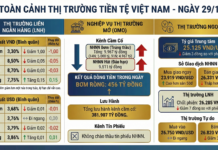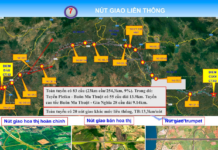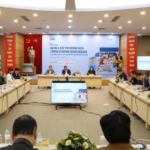
Supply chain shifts will require investment linked to high-tech production. (Photo: Vietnam+)
|
In the new context, many large international corporations and businesses are making changes to their supply chain structure to align with global production networks. Along with this, production and business activities are also being innovated, given the remarkable achievements in digital technology applications.
This poses new requirements for Vietnamese enterprises aiming to participate in the global supply chain.
Vietnam’s Advantages in Joining the Global Supply Chain
According to Dr. Nguyen Bich Lam, former General Director of the General Statistics Office, the global economy is facing many uncertainties. In addition, the competition among major countries is changing and disrupting the usual rules of the global economy.
Among these changes, new trends in supply chains are emerging, requiring businesses to be agile and actively adopt digital technology. Moreover, global production networks will determine the future of supply chains, along with the strong development of regional production networks. At this stage, globalized services, information technology, and research and development will create new growth opportunities, accompanied by global competition. In addition, the development of regional supply chains can increase inflation, leading countries to raise their inflation targets.
Dr. Lam emphasized three trends that will change the global supply chain in the coming time: First, the shift of supply chains to countries in the same geographical region (to avoid dependence and reduce risks). Second, the supply chain shift will require investment linked to high-tech production (this has already occurred in developed countries such as the US and the EU). Third, the restructuring and reorganization of supply chains will be associated with diversifying sources of supply and expanding markets.
Regarding Vietnam, Dr. Nguyen Bich Lam believes that the country has many advantages that can be leveraged to participate more deeply in the global supply chain. Specifically, Vietnam is a potential market with a population of 100 million and a favorable geographical location, making it an attractive destination for foreign investors. In addition, Vietnam has a high degree of economic openness, with 17 free trade agreements. Vietnam is also highly regarded for its role in connecting the segmented economy. With strong commitments made at the COP 26 conference, Vietnam is well-aligned with the trend of developing a green and circular economy. As evidence, many large investors have come to Vietnam, bringing with them new scientific and technological applications, such as the carbon-neutral Lego factory project.
 Each supply chain typically has five groups of partners, including raw material suppliers, manufacturers, distributors and logistics providers, retailers, and customers. (Photo: Minh Son/Vietnam+)
|
Along with these advantages, Dr. Nguyen Bich Lam pointed out that domestic enterprises also face challenges when participating in the global supply chain due to their weak internal capacity and low competitiveness. In addition, the auxiliary industry is still underdeveloped, and the country relies on external sources for raw materials and resources; technology and production methods are outdated, labor productivity is low, and there is a plethora of regulations, administrative procedures, and policies.
Additionally, Dr. Nguyen Bich Lam noted that each supply chain typically consists of five groups of partners, including raw material suppliers, manufacturers, distributors and logistics providers, retailers, and customers. However, Vietnamese enterprises only focus on being manufacturers of goods and pay less attention to the other groups of partners.
Maximizing Advantages
Given this context, Dr. Nguyen Bich Lam proposed the need to develop a strategy for “national enterprises” to keep up with the trend of reshaping and shifting supply chains. To achieve this, he suggested that the government should play a supportive role. Along with this, the government should consider the conditions and mechanisms to encourage foreign investors to come to Vietnam with a mindset of joint investment and production. From this perspective, the effectiveness of FDI attraction can be enhanced while filtering and orienting investments, thereby reducing risks.
According to Dr. Nguyen Bich Lam, Vietnam needs to fully implement its commitments in FTAs to enjoy sustainable and long-term benefits. On this basis, domestic enterprises can maximize their role and benefits in the connected economy and proactively develop strategies to participate in global services.
With the strong development of technology, trade and investment activities worldwide are witnessing significant changes. Dr. Nguyen Tu Anh, Director of the Information, Analysis, and Economic Forecast Center, Central Economic Committee, emphasized that while geographical distance used to determine trade and investment in the traditional model, this is no longer a deciding factor today.
According to Dr. Nguyen Tu Anh, Vietnam has a special position in connecting with the trends of polarization and the emergence of new poles. Capital inflows from China, the US, Japan, South Korea, and other countries into Vietnam continue to increase rapidly. In addition, the government is highly focused on resolving the “bottlenecks” in the economy, such as infrastructure, port upgrades, and highways. However, enterprises need to anticipate risks and challenges and proactively seek solutions to seize opportunities.
Hanh Nguyen
SeABank records pre-tax profit of over 4,600 billion dong in 2023, with strong CASA growth
SeABank, a commercial bank in Vietnam, has recently announced its 2023 business results with impressive growth indicators. The non-term deposit-to-total deposit ratio (CASA) reached 11.5%, surpassing previous years. The outstanding loans and mobilized capital grew by 16.76% and 25.35% respectively compared to 2022. The non-performing loan ratio was controlled at 1.94%. The bank’s pre-tax profit reached over 4,616 billion VND.
Achieving Success in Meeting the Development Goals and Objectives of the Social Welfare Sector by 2024
The government requires central and local agencies to vigorously and effectively implement coordinated tasks and solutions to promote the disbursement of public investment funds by 2024.







































